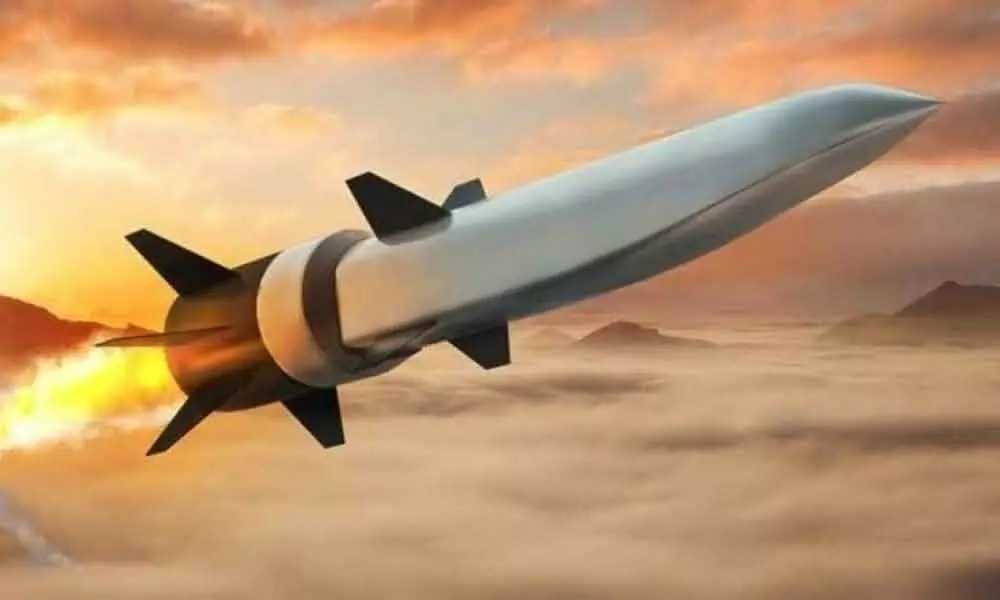China's hypersonic missile test likely to trigger global race for arms
Given the recent incidents along LAC, aggressive manoeuvres in the South-China Sea and the repeated standoff over Taiwan, ‘China is a challenge’ to the global and regional peace; India has no option but to accelerate its hypersonic missile program and simultaneously develop effective countermeasures
image for illustrative purpose

China has kick-started a new 'arms race' by secretly testing, in August this year, its 'nuclear-capable hypersonic glide vehicle' (HGV). According to multiple news reports, the Chinese 'long-range hypersonic weapon' travelled at more than 'five times the speed of sound' while gliding 'through low-orbit space, and it circled the globe before hitting within 40 km of its target in China.
None other than General John Hyten, vice-chairman of the Joint Chiefs of Staff and the No. 2 person in the US military, confirmed the Chinese test. The US intelligence community is not just surprised at China's 'astounding progress' in developing hypersonic weapon capability; they compare the recent test to the Sputnik moment of the 1960s. In 1957, during the arms race with the Soviet Union, the US was surprised when Moscow launched the Sputnik satellite into space and became the first nation to do so. Intelligence and defence officials have warned that the Chinese hypersonic weapon test 'marked a significant technological leap that could threaten the US in new ways.'
What is a hypersonic weapon?
A missile that 'travels at hypersonic speed, generally defined as Mach 5' (five times the speed of sound) or greater. There are two types of hypersonic weapons - a cruise and glide vehicle. A cruise missile is powered by an engine while a glide vehicle is launched using a rocket into the 'upper atmosphere, from where it dives down on to a target.'
Are ICBMs hypersonic weapons?
Intercontinental ballistic missiles (ICBMs) meet the definition of hypersonic weapons when they re-enter the atmosphere from space. However, the biggest disadvantage of ICBMs is they 'arc along a predictable path'; thus, long-range radars can track them. They lack the element of a surprise, according to defence experts. In contrast, a hypersonic weapon flies at lower altitudes between '20 to 30 km above the earth's surface.' And its manoeuvrability enables them to easily evade radar and avoid countermeasures. Thus keeps 'an adversary guessing about the target.'
Is China the first nation off the block on hypersonic weapons?
For decades, global powers 'have coveted' hypersonic missiles. During the 1960s, the Soviets had developed the 'Fractional Orbital Bombardment System (FOBS), and was 'operationally deployed in the 1970s to bring a missile into Earth's low orbit.' For nearly three decades, the US, too, has been developing hypersonic weapons technology. However, in recent years, the race to have a credible hypersonic weapon capability has gained pace.
Currently, the US, India, Russia, China are the four countries that have developed and tested hypersonic weapons technology. Further, countries such as India, Australia, Japan, and France are developing hypersonic capability either through teaming with other nations or through independent programs.
BrahMos-II will be India's hypersonic cruise missile with a range of 1000 kilometres and a speed of Mach 8. The missile is jointly built by India's Defence Research and Development Organisation (DRDO) and Russia's NPO Mashinostroyenia. India is building a deterrence to counterbalance the threat emerging from Chinese hypersonic capabilities.
How is China fuelling a new arms race?
According to observers, China usually announces the launch or test of long-range missiles. The China Academy of Launch Vehicle Technology, the government agency that monitors launches, had mentioned its 77th and 79th launches on its official social media. However, it conspicuously concealed the August launch or the 78th launch, Which sparked speculation among China space observers of a secret launch. The Chinese foreign ministry denied testing a hypersonic missile instead maintained that 'a routine test of a space vehicle to verify technology of spacecraft's reusability' was performed. All this without explaining 'why China did not announce the test at the time.' As always, there is a question mark on China's capability and its intent- as both lack credibility.
At a 2017 hypersonic conference in Xiamen, China, Chinese scientists presented more than 250 papers - about 10 times the number presented by US researchers. Further, reports also claim that in 'the last five years, China has carried out hundreds of hypersonic tests, while the US has conducted just nine.'
Besides, there are also reports of China building 'hundreds of new missile silos' that could be used for launching a surprise nuclear strike. Numerous news reports suggest that the global intelligence community, military observers and geostrategic analysts believe that the latest test has brought hypersonic weapons back into focus. There is now a sense of urgency among nations to pursue this "cutting-edge technology" to impact future military strategy.
Way forward for India
Given the recent incidents along Line of Actual Control (LAC), aggressive manoeuvres in the South-China Sea and the repeated standoff over Taiwan, 'China is a challenge' to the global and regional peace. As a result, like other developed nations, India has no option but to accelerate its hypersonic missile program and simultaneously develop effective countermeasures.
(The author is Founder of MyStartup TV)

